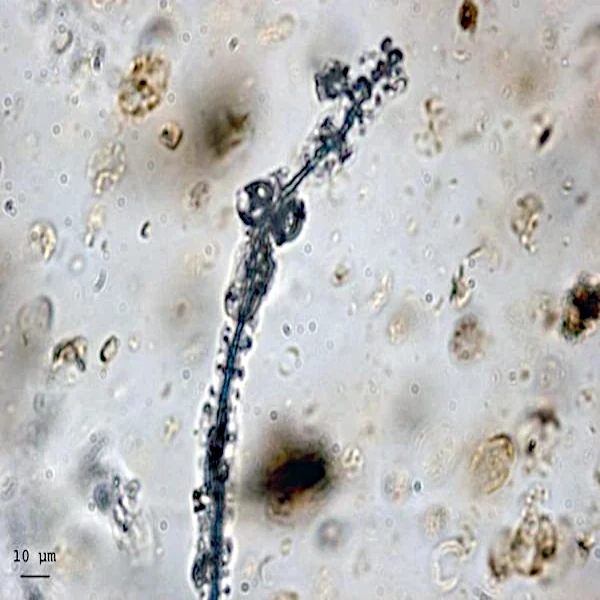
About 2.4 billion years ago, a major geological and biological event disrupted the history of Earth: the Great Oxidation, also known as the GOE (Great Oxidation Event). Before this period, Earth's atmosphere was almost devoid of free oxygen \((O_2)\) and dominated by gases such as methane, ammonia, and carbon dioxide. This drastic change was triggered by a group of photosynthetic microorganisms: cyanobacteria. By using solar energy to oxidize water \((H_2O)\) and release oxygen, they irreversibly altered the composition of the atmosphere.
Cyanobacteria, also known as "blue-green algae" (though they are not algae in the eukaryotic sense), are prokaryotic microorganisms that appeared more than 2.7 billion years ago. They are the first known life forms capable of performing oxygenic photosynthesis, which releases oxygen by oxidizing water \((H_2O)\) using solar energy.
Their photosynthetic apparatus, integrated into thylakoid membranes, uses two photosystems in series (PSII and PSI), a mechanism more complex than that of anoxygenic bacteria. This bioenergetic innovation allowed them to exploit an abundant resource (water) as an electron donor, leading to massive production of molecular oxygen \((O_2)\).
Cyanobacteria are capable of forming microbial mats, called stromatolites, which have left fossil traces in Precambrian carbonate rocks. Their metabolism profoundly modified the terrestrial environment by first enriching the oceans and then the atmosphere with oxygen, paving the way for the evolution of aerobic respiration and the emergence of complex organisms.
Even today, cyanobacteria play a fundamental ecological role: they participate in nitrogen fixation \((N_2)\), oxygen production in aquatic ecosystems, and some species live in symbiosis with lichens, ferns, or mosses. Their biochemical legacy is found in the chloroplasts of plants, resulting from the endosymbiosis of an ancestral cyanobacterium with a primitive eukaryote.
| Period | Event | Estimated Duration | Major Impact |
|---|---|---|---|
| ~2.7 Ga | Appearance of the first cyanobacteria | — | Beginning of oxygenic photosynthesis |
| ~2.5 – 2.45 Ga | Oxidation of the oceans (formation of BIF) | ~50 Ma | Precipitation of iron oxides in the oceans |
| ~2.45 – 2.1 Ga | Great Oxidation (GOE) | ~350 Ma | Significant increase in atmospheric \(O_2\) |
| 2.1 – 0.8 Ga | Stagnation (low \(O_2\) level) | ~1.3 Ga | Balance between oxygen production and consumption |
| ~800 – 600 Ma | Neoproterozoic Oxidation Event (NOE) | ~200 Ma | Additional increase in \(O_2\), preparation for complex life |
| ~600 – 541 Ma | Ediacaran | ~60 Ma | Formation of ozone and appearance of macroscopic multicellular organisms |
Source: Nature Geoscience – Holland (2009), PubMed – Lyons et al. (2014)
The oxygenic photosynthesis carried out by cyanobacteria follows the overall reaction: \(6CO_2 + 6H_2O + \text{light} \rightarrow C_6H_{12}O_6 + 6O_2\)
Initially, the oxygen produced did not accumulate in the atmosphere, as it reacted with reduced elements present in the oceans, such as iron \((Fe^{2+})\), forming banded iron deposits (BIF: Banded Iron Formations). It was only once these reservoirs were saturated that oxygen began to escape into the atmosphere, profoundly transforming planetary chemistry.
The appearance of free oxygen in the atmosphere had multiple consequences:
The Great Oxidation is often seen as a prerequisite for the explosion of biological diversity. Oxygen allowed the development of more efficient metabolisms (aerobic respiration), favoring the evolution towards more complex organisms. But this transition was not instantaneous: the atmosphere only reached levels comparable to those of today much later, about 600 million years ago, at the dawn of the Ediacaran (635 million years to 541 million years before present).
| Parameter | Before the GOE | After the GOE |
|---|---|---|
| Oxygen \((O_2)\) | %< 0.001 % | ~1 to 2 % (then gradual increase) |
| Methane \((CH_4)\) | ~1 % | %< 0.0002 % |
| Carbon dioxide \((CO_2)\) | > 10 % | %< 1 % |
| Presence of ozone \((O_3)\) | Nonexistent | Appearance in the stratosphere |
| Dominant life | Strict anaerobes | Emerging aerobes |
Source: Nature Geoscience – Holland (2009), PubMed – Lyons et al. (2014)